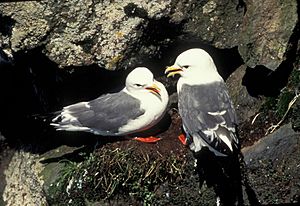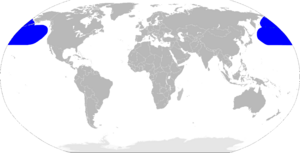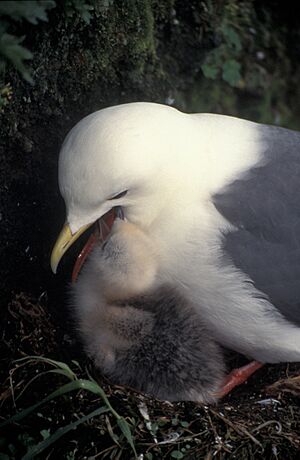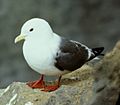Red-legged kittiwake facts for kids
The red-legged kittiwake (Rissa brevirostris) is a type of seabird that belongs to the gull family. These birds are special because they have bright red legs!
Quick facts for kids Red-legged kittiwake |
|
|---|---|
 |
|
| Red-legged kittiwakes, St. George Island, Alaska | |
| Conservation status | |
| Scientific classification | |
| Genus: |
Rissa
|
| Species: |
brevirostris
|
 |
|
You can find red-legged kittiwakes breeding in specific places. These include the Pribilof Islands, Bogoslof Island, and Buldir Island in the Bering Sea, which is off the coast of Alaska. They also live in the Commander Islands in Russia. When winter comes, they fly out to sea.
Contents
What Does a Red-legged Kittiwake Look Like?
The red-legged kittiwake is a unique bird found in the cold, northern parts of the Pacific Ocean. As its name suggests, its most noticeable feature is its red legs!
It looks a lot like its cousin, the black-legged kittiwake. But there are a few ways to tell them apart. The red-legged kittiwake has a shorter beak and bigger, rounder eyes. Its head is also larger and more rounded. Plus, its wings are a darker shade of grey.
Young red-legged kittiwakes look very much like the adults. They don't have the black tail band or the 'W' shape on their wings that young black-legged kittiwakes have. It takes three years for young kittiwakes to become fully grown adults.
Adult red-legged kittiwakes are about 35 to 39 centimeters (14 to 15 inches) long. Their wings can spread out to about 84 to 92 centimeters (33 to 36 inches). They usually weigh between 325 and 510 grams (11.5 to 18 ounces).
Like some other kittiwakes, the red-legged kittiwake has a well-developed back toe. Sometimes, a black-legged kittiwake might have reddish legs. So, if you see a bird with red legs outside of the northern Pacific, it's important to look for all the other differences to be sure it's a red-legged kittiwake.
Red-legged Kittiwake Behavior and Diet
Red-legged kittiwakes are skilled hunters. They mostly eat fish, like lanternfish, and also enjoy squid and other small sea creatures without backbones.
During the summer, these birds gather at special places called cliff breeding colonies. This is where they build their nests on rocky ledges. In September, they leave these colonies and fly out to sea. They spend the winter in the northwestern Pacific Ocean and the Gulf of Alaska.
Why Are Red-legged Kittiwakes Vulnerable?
The red-legged kittiwake is listed as a "Vulnerable" animal by the IUCN. This means their population seems to be shrinking.
There are about 337,000 to 377,000 adult red-legged kittiwakes in the world. Their breeding areas cover about 192,000 square kilometers (74,000 square miles).
Scientists believe their numbers dropped by about 35% between the mid-1970s and the mid-1990s. While their population might have become more stable recently, it's not clear why they declined in the first place. It could be because there's less food available for them to eat. This might be due to too much commercial fishing or changes in the climate.
Images for kids
See also
 In Spanish: Gaviota piquicorta para niños
In Spanish: Gaviota piquicorta para niños








